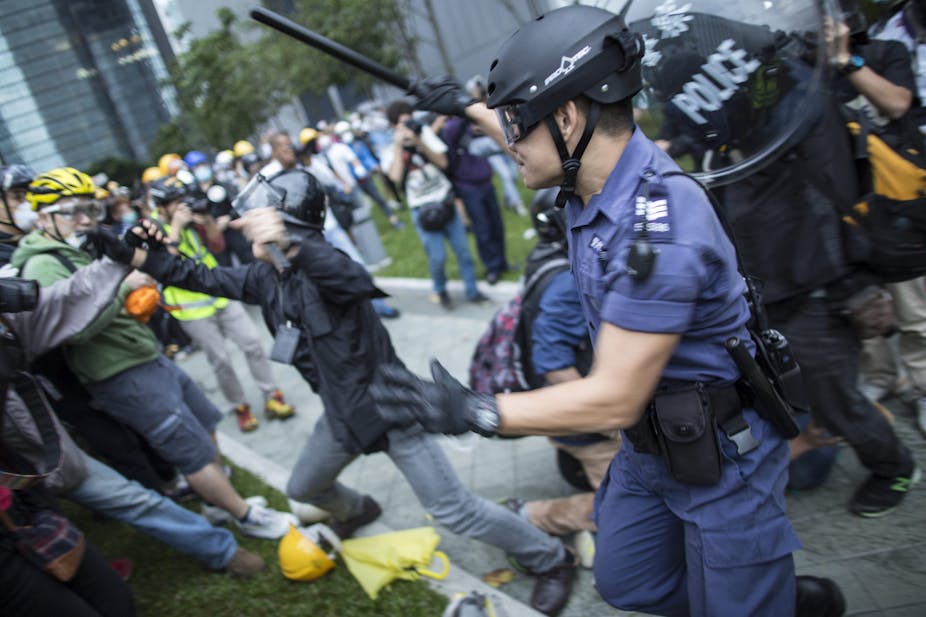The umbrellas were out in full force on Monday night in the Admiralty district of Hong Kong – but mainly because it was actually raining. A few hundred people, myself included, had shown up to listen to speeches by student leaders and activists.
Many of the people around me were young, some very young, including quite a few wearing school uniforms and proudly sporting yellow ribbons and matching umbrellas.
On the makeshift stage in the cordoned-off area known as “Umbrella Plaza”, several speakers climbed ladders from where they addressed the crowd. Those calling for more violent action had their faces covered. At some point open disagreement broke out between two speakers, with the crowd shouting their support for either side.
Eventually the main student leaders took to the stage and apologised for the miscalculated escalation of the movement the night before. The students had galvanised the crowd to push towards the nearby government buildings, only to be beaten back by police using batons and pepper spray.
Spirit of peaceful protest lost
Many had been disappointed by the provocative move. Reporters from the South China Morning Post – whose coverage throughout has been excellent – recorded widespread disappointment among demonstrators that the spirit of peaceful protest had come to an end.
As I write I see a new announcement. The leaders of Scholarism, one of the three main protest groups, representing mainly secondary school pupils, have decided to go on hunger strike.
Since I arrived in Hong Kong last Friday night, many people have told me that this will be the last week of the protests. Various reasons are given but foremost among them is increasing public dissatisfaction with the stalemate between the protesters and the Hong Kong government, which involves the continued closure of a main road in a very busy part of the city. The daily traffic jams and delays in getting to or from work are starting to annoy even those people who rationally sympathise with the movement.

The older activists, being public intellectual figures who came up with the idea to “Occupy Central”, have also gone on record saying they would end their protest this coming week and think of new ways to pursue the point that it is all about: achieving genuine universal suffrage for the 2017 elections.
Then there are those who believe that the government wants to clear away the protesters’ camp before Christmas. It seems unlikely, though, that the government will see the need to change its waiting game as long as support for the movement is dwindling of its own accord.
Occupation tests public patience
It is hard to say how widespread the support still is. Some people here assure me that the demonstrations never represented the views of a large majority. Opinion was always split between those wanting to challenge the Hong Kong authorities (and those in Beijing), those who feel that antagonising Beijing is the wrong course of action, those who worry about their vested business interests with mainland China, and those who simply don’t care either way.
Even the media landscape here is mixed. When I turn on my television I see Hong Kong-based channels that report on the movement at length and with sympathy, as well as channels that dismiss it as an “illegal occupation”.
Outside the protest areas life goes on. Millions of people go about their business without giving the movement much thought. Many say they hope it will conclude peacefully. They do not want to see the young students come to harm, but many also insist that the rule of law is what matters most – and keeping a main street occupied for so long is against the law.
From my personal perspective, walking along the occupied road before the violence flared, reading the slogans, laughing about the puns and the cartoons, and admiring the organisation and cleanliness of the tent village that sprang up along a major traffic artery, I could not help but be impressed.

The reality of one country, two systems
Yes, there is a stalemate. Yes, the student demands are unrealistic and will not be met. Yes, there is a chance that this will all end very badly, but still what I was watching was something that could never be seen anywhere else in China.
Last week I was in Shanghai, where information about the events in Hong Kong is tightly controlled. More significantly, nobody seems to care even if they do get the information. Mainland Chinese widely consider the Hong Kongese to be “spoiled” and in some sense they are. If protests like this were attempted in Shanghai, the authorities would end them within a day.
This is the reality of “one country, two systems”. The Hong Kong system really is different. Having direct elections for the Chief Executive in 2017, even without universal suffrage, will still increase rather than decrease the gap in democratic mechanisms between the mainland and Hong Kong.
The real problem therefore is, as one of my conversation partners here put it to me, not how to operate the “two systems” but how eventually to fit them into “one country”.

